Experimental Adapatation
Pitch Black
Designers Dev log to adapt “DooM” for blinds
Experimental Adapatation
Designers Dev log to adapt “DooM” for blinds
The concept of “a game without visual” is not very new. There are games that were trying to capture the ludic element through audio only games. Yet there were always some visual queue to guide the player. This time we decided to go without any kind of visual queue – in one word “blindfold” the player.
“Doom” franchise starts on 1993 by id software and still waiting for it’s next sequel to release. Throughout 26 years, this game faces a lot of sequels, spin-offs and even a movie has been adapted. It was a 3D FPS shooter game which laid down the genre and still popular among gamers. Many game designer/developer has been inspired by this game – even for me. I remember playing “Doom II” before my exams to refresh my mind.
From the narrative perspective, “Doom” is a game which setup in a research lab in planet Mars. Where a Marine try to get out from the lab and destroy it. However, in the film, it was shown that the vaccine can turn people into monsters. The film grossed only 56 million USD compared to its budget of 65 million USD. The film adapted the essence of FPS gameplay, maybe the first time in a film. If you are interested please have a look from the FPS perspective in the film:
Hermeneutically, the game symbolizes power fantasies through gore, guns and braggadocio. It is a fight between good and demons. The game is about from nothing to be the hero who stops demons from being hell. Many critics also debated that this game opens the hell and provoke violence.
Additionally, “Doom (2016)” is known for its amazing sound design. Even though it has a dark sequence where the player has to pass through dark halls with very limited visibility. The sound is designed in a way to triggered the horror, yet help the player to pass through the level. Here is the link for the specific sequence:
Considering all these, we decided to make our game doom-like horror action genre. Besides, our approach is to make player feel being a blind person, to make them aware that blindness is not a weakness.
To make a game without visual is not as easy as it seems. We have to look for how to give complete feedback with audio and other features available – like vibration from the controllers. Besides it is not the first game without visuals. There are games like – Perception (2017), The Vale (TBA), A Blind Legend (2016), Blind Archer (a CGL Project, SoSe 2018), enemy zero (1996) etc. These game has very limited visual or no visual at all. We tried to discover the game mechanics and their review on how a game without visual may work.
Additionally, there is a famous sport for blind called “Goalball” which are played on international levels. Understanding and learning about this sport helps to understand the ludic element of play only with sounds. Besides that, it is also taken into consideration on how to navigate with white cane. Obviously, we will need suggestions and guidance from people who use white cane.
It’s important to make a good connection with 3Cs – Character, Camera and Control to communicate with player properly.
Character: primarily, it is decided that the character will be a marine on his mission in another planet to rescue people. Unfortunately, there is an accident, (s)he survives but lost his/her eyes. Obviously, we don’t want to make this game questioned with the gender of the marine. Importantly, the main protagonist is blind and find a weapon/navigating system. The weapon can be used as navigation like the white cane, whereas also can be used to slash the enemy.
Camera: a game without visuals doesn’t have any camera in a sense. But considering the movement and control it has an invisible camera which actually helps to listen the sounds or interacting with the environment.
Controls: our approach is to make the game minimalist in terms of control. Considering, it is hard to get into something which is unusual. It will be harder for the gamer to adapt into the system where there will be no visuals. So to make it easier, minimalist control may help. The two thumb stick and vibrations will be used for navigating and movement. One single button will be used for attack/reflect/interacting. Here is the basic idea for controls of the game:
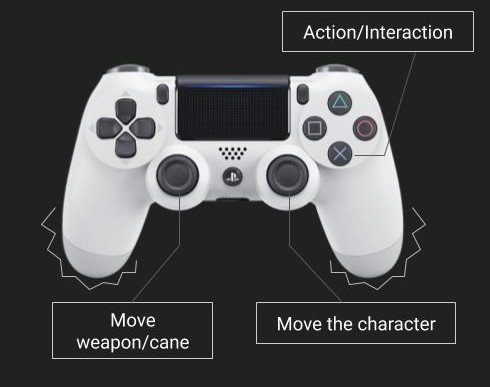
As we mentioned earlier, we are trying to adapt “Doom” franchise, it’s important to understand how the game works. To make it easier, we selected one episode from the original series – Doom II.
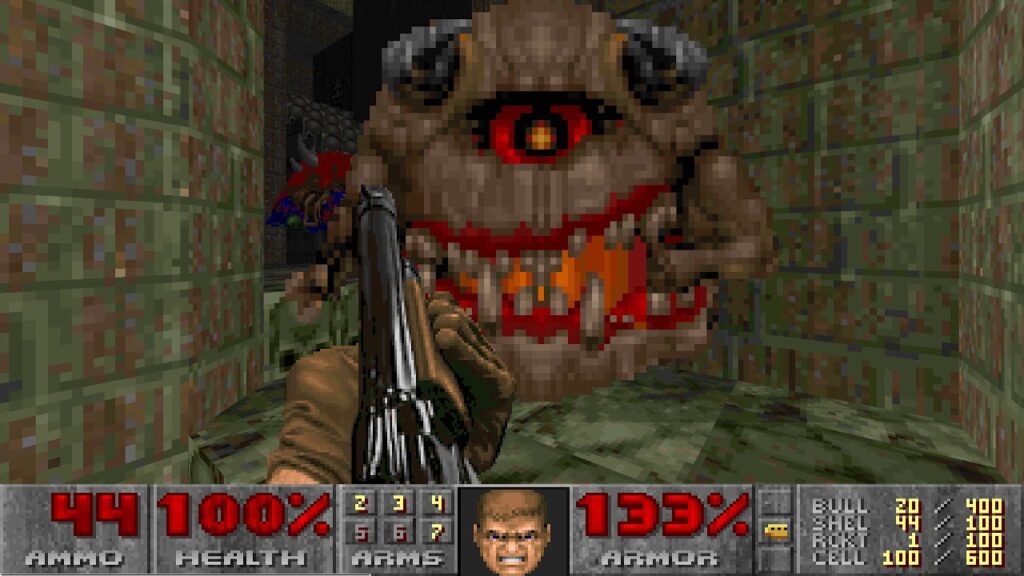
“Doom 2”
The game was successful in term of 3D perspective in the first place. The game has very first type of FPS camera – fixed position and fixed target. The movement of camera is linked with the character movement. At the same time, the camera didn’t move up or down. It only move in one dimension i.e. Z axis. Interestingly, the game has minimal control at the same time. There is not top/down rotation, and no left/right movement so that the game can be played only with directional buttons or one stick from the controller along with two interaction buttons.
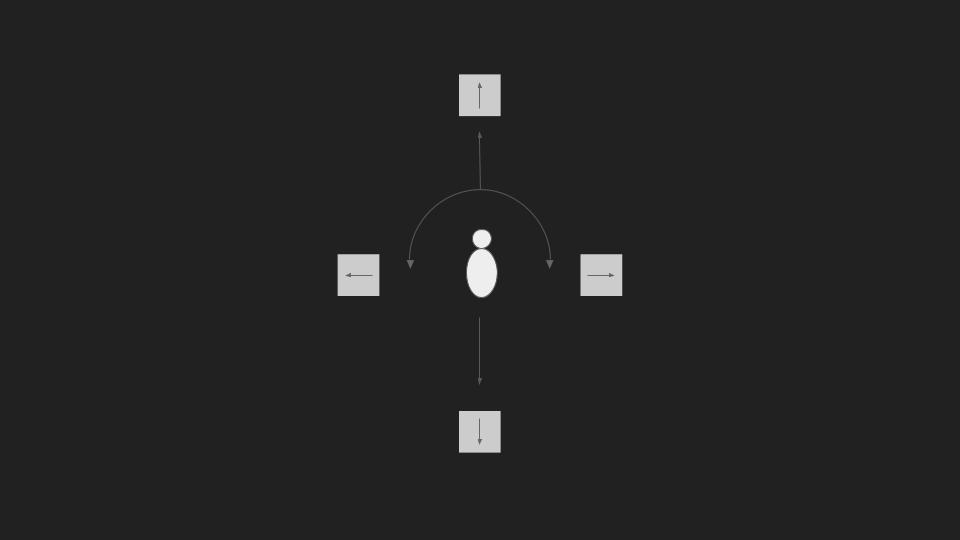
“Doom 2” – the connection between 3Cs
From the understanding of “Doom II”, we have decided to go with two system – navigation and combat. The navigation system is used for navigation the player in the game world. As there will be no visual so audio and vibration of the controller will help the player to progress. Primarily, we want to use the basics of “white cane” and implement it in the controller one for the cane and another for the movement. While the combat system will be used for slashing the enemy with one hit along with the cane rotation to hit perfectly. We still need to finalize about the control and movement of character through playtesting.
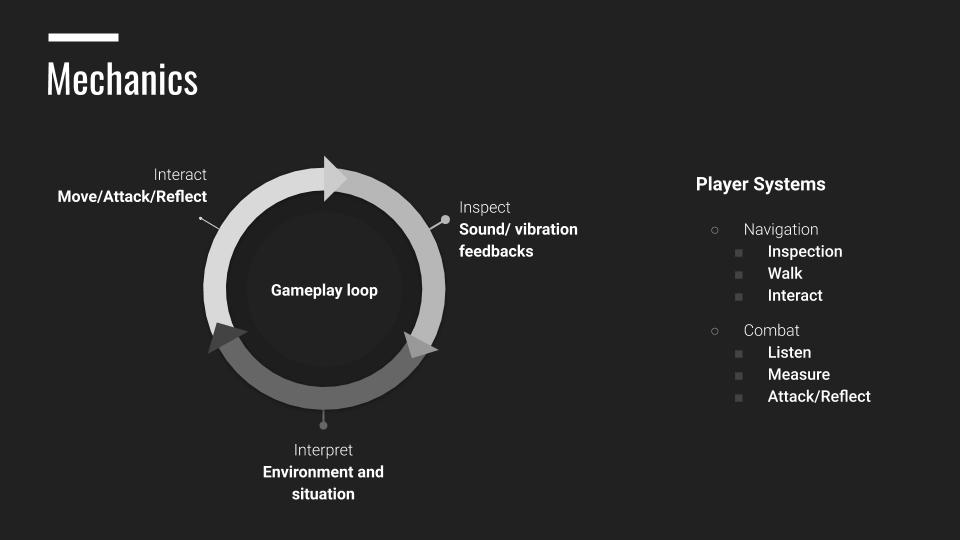
The game “Doom II” uses pixelated graphics due to technical limitations. That time it was a great step towards 3D games. The repetitive walls, corridor and different types of enemies, few puzzle elements etc. keep the gameplay fluid. The dark tone, grungy futuristic setting, unnatural color and environment set the mood. The UI at the bottom showing armor, health, ammo, even a small avatar of the player gives the information all the time. Considering these, it may seem that there are a lot of elements for the levels, however, there is not that much. Levels are made in this game based on doors, corridors and different types of enemies.
In summary, “Doom” doesn’t use many elements to create the levels, rather use the same assets differently to increase complexity. Similarly, we want to try in our game to keep everything minimalist. Our levels will be designed only with doors, corridors and enemies. It’s important to guide the player in each level to an objective. We want to use the doors as the objective. So that the player always knows where to go. The doors will have a specific sound to guide the player, while they have to pass through the corridors or rooms to reach that door.

The first issue arises when we tried to decide about the gameplay. The game mechanics seems a bit complex. Adding a feature for “white cane” seems a bit costly in term of minimalism and confused. At the end of the week, we have the first playable version with the controller. After playing it seems that the rotation/white cane system doesn’t work as it seems. The first playtesting with one gamer has been done. According to her feedback, the game is easier when there is no white cane mechanism, so did I. At the same time, it’s hard to find a blind person as a consultant. However, we are still searching. Additionally, without a tutorial level, it seems that it’s easy to get confused and lost in a level. As human perception varies from person to person, it is important to define the system in the beginning. So, before going to CGL summer camp, the very first issues are on the tables.
Using white cane mechanics requires an additional control group/buttons without adding any values. It makes the system more complex. So here comes two proposals which we want to try:
Proposal I: Between the two controller stick – one will be used for player rotation and another will be used for movement. Rather than using a complicated and extra element, the player will be himself detect the collision depending on his/her movement. The vibrations will be left/right/forward based on the position of the player and the obstacles. However, still a bit complicated and unnecessary buttons.
Proposal II: Use the exact same types of control of “Doom 2”. It makes the game minimalist. Although, the question remains – is it intuitive?
Even though, these two proposals may work, still one of the problems remains – how will the player inspect the surroundings? Or how will they understand that there is something in front of him/her without hitting/crash on it?
To solve the issue, a double collider system may implemented as shown below:
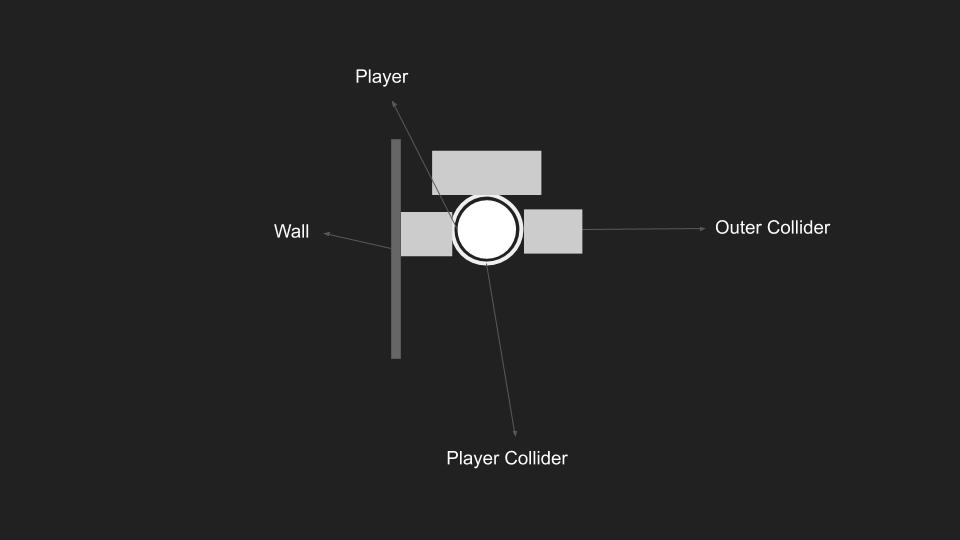
The outer collider will give a low intensive vibration when it hit any obstacles so the player will know beforehand that something is in the way. On the other hand, player collider will get a high intensive vibration and additional sounds to make them feel that they hit something hard – either the wall or enemy.
In the first prototype, we have used some collected resources from the internet. Having no sound designer with us, it is hard to create and design new sounds. So we have decided to use collected resources now. After getting the first playable prototype with proper mechanics and gameplay – we can start creating our own sounds. Besides, here is a link for the original sound effect from “Doom”:
https://www.newgrounds.com/portal/view/488233
For technicality, we have decided to use Steam audio with Fmod in unity. Although, in the first prototype we use the basic unity sound api.
After updating the control and collider system, we have decided to make a playtest. According to playtest we get some feedback:
After the playtest, we have to decide about refining the feedback system, setting up a mood, mixing up the sounds, a solution to the collider system.
From the beginning, it has been decided to create a blind experience for sighted people. Although, it is in a controlled setting, there are few more things to decide. Different type of blind people visualize in different ways [1]. As a result, it is hard to decide on what types of experiences we want to create. The way blind people from birth (congenital) or sight lost (adventitious) experience the world is different.
Additionally, it seems that people who lost sight go through different mental phases. Also, they got isolated and depressed [2]. Whereas, the brain of congenital blind person develops differently from their early ages. [3]
Noted that, different types of methods are also used to guide blind people. They can be introduced to a new layout by direct experience and tactile map or by direct experience with verbal guidance. However, these methods are not perfect and effective. Using both methods in a combination can be a solution to guide blind people to new layout.4 Although, there is no experiment which stated about how to guide a sighted person in short-term blindness (blindfold).
From the literature, it seems that the experiment for this basis needs to be more specific and requires time. Within this short period, we have decided to focus on creating a game without visuals.
As mentioned earlier, we have started to look for new sounds. We want to adapt “DooM(1993-1994)” which has creepy and edgy sounds. The game is scary and trigger fear. Luckily, a sound bank from the game is available. So it is decided to use the sound bank for our game.
In addition, some more sounds were required. We have collected and edited those sounds from the CGL sound bank. Noted that, using the original game sound bank put our game into a mood.
The first step to do that, we refined the list of feedback. We have added pitch to the door sound so that the player always gets a feeling of progression. Besides, the enemy footstep sounds were changed as they were conflicting with player footsteps. Other changes were made to give more distinctive and specific feedback.
Vibration settings in the controller were not distinctive and mostly non-distinguishable. So we had to come up with a new system. We have added continuous vibration when the player touch or hit the wall. As a result, the player understand it more when they are approaching an obstacle. It helps to clear up some confusion.
Designing levels for a game without visual is tricky. From the last playtest, we have understood that it is better to keep them linear. Using the doors in left or right makes the player confused. So the levels are designed in a way that it always straight to the player. So that they can set up their targets in the beginning of each level.
Besides that, the levels are widened enough so that there are no false signal. Congested levels gives false signal when the player tries to turn.
Additionally, the levels are made based on difficulty progression. The first level doesn’t contain any obstacles, it is straightforward and used as a tutorial level. From the second level enemies, obstacles are introduced one by one.
In the first playtest, we all felt that we required a tutorial level. As there is no visuals, we have decided to make it with narration. I have written the script. Primarily, my approach was to make it digestive. But it is not purely effective, so the script has to be changed a few times.
Besides, the menus are also included so that the player can pause or restart the game.
After, refining the feedback and vibration, setting up the game mood and including the tutorial, we went for another playtest. This playtest gives more satisfaction as the players were able to play the game without help, had less confusion and they could feel the mood. Here’s the video form the playtest:
https://drive.google.com/open?id=1Rkxzys0hF3GzITSGBiKyV2PKYnSpuG1R
Notably, the lights were turned on in the project so that we can see how the player reacted to the game, whereas, the screen was placed completely opposite to the player so that they don’t see anything.
After doing the playtest and few more tweaking, we tried to make a list of findings about creating a game without visuals:
Although, choosing “DooM(199301994)” as for the base of the game gives some ideas:
It was a nice journey from the beginning. This project helps me to understand more about the feedback system as well as the way of designing sound. It’s interesting that other feedback techniques like vibration is also an important part of immersive experiences.



